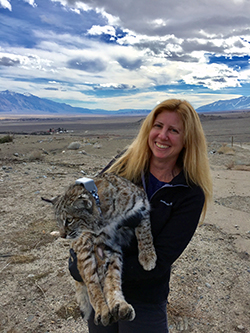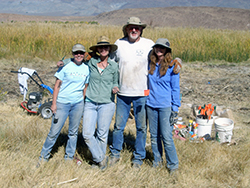
Alisa Ellsworth holds a newly-collared bobcat for the Eastern Sierra Bobcat Project.

Alisa Ellsworth and crew working on Fish Slough Ecological Reserve restoration project.
CDFW Senior Environmental Scientist Alisa Ellsworth supervises the Inland Desert Region’s Northern Lands Program. Based out of the Bishop office, Alisa oversees 10 employees who perform a wide variety of activities including land acquisition planning, coordinating mitigation for incidental take, and managing over 120,000 acres of state ecological reserves and wildlife areas in Inyo, Mono and San Bernardino counties.
A Central Valley native, Alisa grew up in Visalia. She attended both undergraduate and graduate school at Fresno State, where she completed a bachelor’s degree in botany in 1993 and a master’s degree in biology in 1995. Her thesis focused on vernal pool ecology in Madera County.
What inspired you to become a biologist?
My interest in science first started in high school when I had to do an insect and plant collection for my biology class. I really enjoyed learning how to identify things in nature. When I started college, I was naturally drawn to biology courses and my path was set. I met a group of people that liked to go out botanizing and birding on the weekends and a whole new world opened up for me.
My first wildlife job was in 1992 with Pacific Southwest Research Station, estimating the density of spotted owls in Sequoia National Park. This is where I learned how to hike at night using a compass and topographic map, as there weren’t GPS units back in those days. The work also involved gathering vital rate data (reproduction and mortality) as well as characterizing diets from regurgitated pellets. In 1993, I spent an amazing summer working for the US Forest Service. I hiked all over the Sierra National Forest, mapping vegetation types and looking for rare plants.
How did you come to work for CDFW?
I worked as a scientific aide for the Habitat Conservation group in the Central Region for a year and a half when I was in college. After I graduated, I began working as a private consultant until 1996 conducting rare plant surveys, wetland delineations and revegetation projects. Around that time, I caught the travel bug and applied for a research assistant position focused on field studies of the guanaco, a South American wild camelid related to the llama. This took me to Torres Del Paine National Park in the Patagonia region of southern Chile, where I worked on guanaco reproductive strategies, spacing strategies and movement. We radio collared young guanacos (called chulengos) and monitored for survival and cause-specific mortality. This involved watching a mother give birth to her baby and then soon after running in and grabbing the baby and quickly putting a radio collar on it. Most of the mothers were pretty mild mannered, but one tried stomping on us and spit all over us, which was quite smelly!
Afterward, I joined the Peace Corps and stayed in Ecuador until 1999, working on environmental education projects in schools. When I returned to the United States, I worked briefly as a consultant again, and then took an associate biologist position with Caltrans in Fresno. When a position opened up in CDFW’s Bishop office, in the streambed alteration agreement program, I jumped at it. I was hired in 2001 and have never wanted to leave Bishop since.
Over my career with CDFW, I have managed the X9B and X9C deer zones, the Owens Valley tule elk zones and the White Mountain bighorn sheep hunt zone. I have collected and analyzed wildlife population data for upland game birds, mule deer, tule elk and Nelson bighorn sheep. I’ve provided harvest recommendations and direction for population management of those game animals. Since 2008, I’ve been with the Lands program, working on acquisition projects, writing grants and working with the Wildlife Conservation Board and other non-governmental organizations on projects of shared interest.
We sometimes say that the Eastern Sierra is “the most beautiful part of California you’ve never seen.” What is unique about this ecosphere?
The Eastern Sierra is comprised of mostly public land with very little development compared to many other areas around California. This allows for intact wildlife populations to exist in vast expanses of native habitat. For example, the federally endangered Sierra Nevada bighorn sheep can be found in the high alpine environment in the summer months. They then move downslope in the winter to take advantage of available food not buried under snow. More than 600 bighorn in 13 occupied herd units can now be found in the Sierras, compared to 1995 when there were only 105 left after being devastated from diseases transmitted from competing domestic livestock in the high alpine meadows.
The sheer beauty of the tall mountains and the abundance of wildlife make it a truly special place. I enjoy hearing the tule elk bugling in the fall evenings near the Owens River. If you really want a treat, you can wake up before the sun rises to go observe the greater sage grouse congregate on their leks (meadows or barren areas with little cover) during the spring breeding season. The males put on quite a display in hopes of attracting a female by puffing out their chest, inflating air sacs and making unique sounds that I equate to drops of water.
What kinds of projects are conducted on the reserves and wildlife areas you manage?
Our activities are quite diverse, including managing water rights and grazing, controlling invasive species and performing various wildlife surveys. I serve as the lead for the Eastern Sierra bobcat study, which was initiated in 2014-2015 as part of a three-year project to assess current populations in Inyo and Mono counties. Specific data collected during the study include bobcat population size, density and age structure, as well as home range size, habitat selection, prey base and reproduction.
I also am also the lead for the low-elevation mesocarnivore survey project. This involves the use of remote cameras to capture detailed images of wildlife species such as bobcat, coyote and gray fox. The surveys help us estimate the percent of the study area that a species of interest occurs by placing one camera within a 10.4 Km cell and surveying 100 cells over multiple weeks. The data collected provides occupancy of the species surveyed. Capture-mark-recapture surveys can be done using this method with species such as bobcats that can be identified because of their unique coat patterns.
Inyo and Mono counties have been divided into eight study areas using geographical boundaries that the mesocarnivore surveys will be rotated through. Initially, these surveys will provide occupancy and abundance of individual species within each study area. Over time, data collected from the surveys can be useful to identify population trends.
What has been the most satisfying part of your CDFW career?
I really enjoy working with outstanding people who are focused on managing and conserving the state’s most important places and wildlife. I’m particularly proud of the conservation work that’s been conducted for the benefit of the Round Valley deer herd. We purchased several important properties within its winter range in Rovana and Swall Meadows, with the goal of protecting an intact migration corridor for them to move up and down in elevation to and from their winter and summer ranges.
What projects would you undertake if you had unlimited money and resources?
I am passionate about conserving natural areas for the perpetuation of healthy ecosystems and the wildlife populations they support. California is an incredibly biologically diverse state and these places are truly unique. By protecting them, we will allow them to be enjoyed generations to come. My most recent focus has been working to conserve the greater sage grouse through land acquisition and conservation easements. Funding all of the proposed actions in the Bi-State Action Plan for Greater sage grouse would be a dream come true.
CDFW photos.
Top photo: Alisa Ellsworth works a Sierra Nevada bighorn sheep capture.